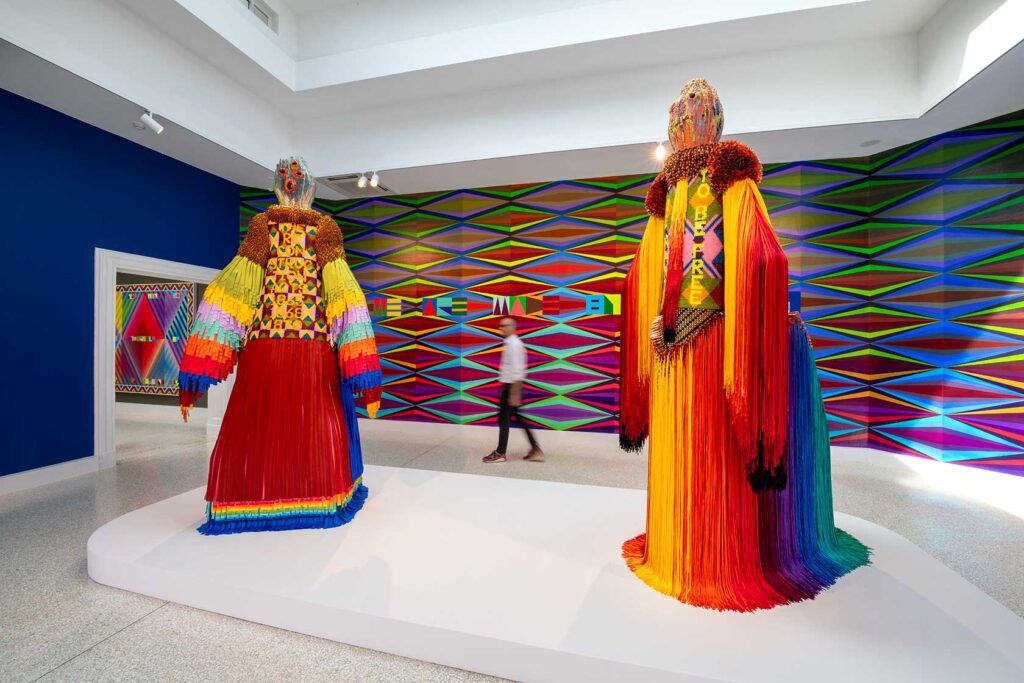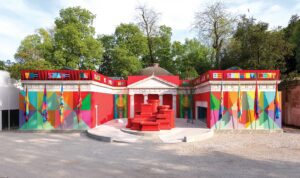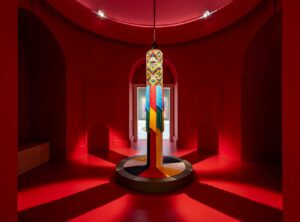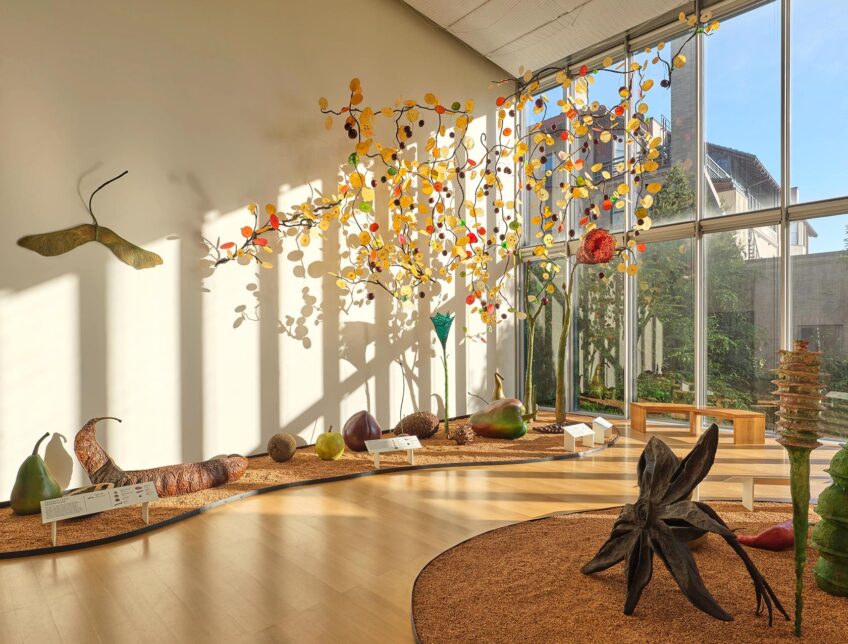
Banner Arts & Culture Sponsored by Cruz Companies
The home of Marco Polo, Venice was once the trading capital of the world. Since 1895, this seaside Italian city has become a world capital of contemporary art as host of the Venice Biennale, the longest-running festival of contemporary art. Every two years, the city’s cavernous Renaissance-era ship-building complex, the Arsenale, as well as palazzos and churches throughout its warren of walkways become venues for countries participating in the Biennale. In Venice’s genteel park, the Giardini, a village of pavilions provides permanent sites for 29 countries. The U.S. joined the party in 1930, with a Jeffersonian pavilion that evokes its democratic ideals.
The 60th Venice Biennale, on view from April 20 to November 24, presents exhibitions from 86 countries that respond to its theme, “Foreigners Everywhere.”

Exterior view of ‘the space in which to place me,’ by Jeffrey Gibson at the Venice Biennale. PHOTO: TIMOTHY SCHENCK
The 2024 U.S. Pavilion presents the first solo exhibition of an Indigenous artist, Jeffrey Gibson. A member of the Mississippi Band of Choctaw Indians and of Cherokee descent, Gibson is a multimedia artist currently in residence at Bard College and will soon have a local presence. In June, Gibson will unveil a mural on the Rose Kennedy Greenway and on Nov. 2, the Massachusetts Museum of Contemporary Art (Mass MoCA) in North Adams will open a massive Gibson exhibition, “Power Full Because We’re Different.”
Gibson joins a recent history of trailblazers at the U.S. Pavilion. In 2022, Simone Leigh became the first Black woman to represent the U.S. with a solo exhibition, commissioned and curated by the Institute of Contemporary Art Boston and presented at the ICA last year.
The 2024 U.S. Pavilion was co-commissioned by Kathleen Ash-Milby, curator of Native American art at the Portland Art Museum, and Louis Grachos, executive director of SITE Santa Fe; and co-curated by Ash-Milby and independent curator Abigail Winograd.

Installation view. Wall works from left to right: GIVE MY LIFE SOMETHING EXTRA (2024); THE RIGHT OF THE PEOPLE PEACEABLY TO ASSEMBLE, 2024. Birds from left to right: if there is no struggle there is no progress (2024); we are the witnesses (2024).
Gibson sets the stately pavilion ablaze with his signature exuberant palette, kaleidoscopic angular patterns, and mix of textiles, ceramics, paintings, sculptures, beadwork and materials that span kitsch and artisanship to create an ebullient declaration of resilience on behalf of people denied power in a flawed democracy.
Injecting a sense of fun at the entrance is Gibson’s ensemble of red pedestals, a sculpture that echoes the pavilion’s elegant columns. Visitors climb on the sculpture and take selfies.
The exterior of the pavilion, which Gibson has painted red, begins the exhibition’s many references to landmark legislation extending citizenship and civil rights to Black people and later to Indigenous people. The front façade displays the exhibition title, “the space in which to place me,” and the phrase “We hold these truths to be self-evident,” from the Declaration of Independence, alongside hand-painted murals and flags mounted on 20-foot teepee poles.

Installation view of “the space in which to place me,” by. Jeffrey Gibson. At center: WE HOLD THESE TRUTHS TO BE SELF-EVIDENT (2024) PHOTO: TIMOTHY SCHENCK
Inside the pavilion, two towering figures dominate the first of five galleries. They are arrayed in streams of beads, ribbon, fringe and tin jingles — elements inspired by traditional Native regalia. Quotations allude to such U.S. legislation as amendments to the Constitution that abolished slavery and protected civil rights of Black citizens. A mural includes a 1954 quotation from Martin Luther King Jr., “We are made by history,” from a sermon urging listeners to actively shape their futures. Works on paper and figures of birds and abstract forms abound in three more galleries, displayed with feel-good aphorisms, some drawn from Dakota proverbs and pop songs.
Nearby, taking the Biennale’s top prize, the Golden Lion, is “kith and kin,” a taut exhibition in black and white by Indigenous Australian artist Archie Moore that turns the Australia Pavilion into a quiet haven of remembrance and connection. On its ceiling and walls, Moore’s chalk-drawn family tree extends across more than 2,400 generations, and framed by a black pool of water, a vast table holds stacks of documents reporting deaths of Indigenous Australians in police custody.
Concluding Gibson’s sensory extravaganza is a nine-screen video installation, “She Never Dances Alone” (2020). Attired in the same palette and mix of embroidery, beads and jingles that dominate the exhibition, Sarah Ortegon HighWalking, of Eastern Shoshone and Northern Arapaho descent, performs a powwow dance. As she moves to the hypnotic beat of Indigenous electronica group The Halluci Nation, her image multiplies and dissolves into abstract kaleidoscopic patterns.
Gibson’s buoyant exhibition celebrates art as a tool to connect and strengthen people with a sense of a shared past, present and future.






